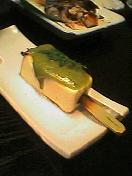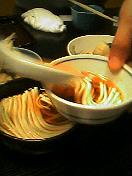It may seem odd to have a restaurant dedicated to just tofu, but this is not uncommon in Japan. Throughout Japan you will notice that most restaurants will specialise in some sort of food, from sushi to sukiyaki, chanko nabe etc. It is only the izakaya or Japanese restaurants outside of Japan that commonly have broader ranges. The reasons for this are apparent in some cases; sushi chefs take up to 10 years to train and not in others.
The meal was more of an assault on the senses than normal. Many dishes were eaten before we could even establish the name. I will attempt to describe:

- Okara. Similar texture to a turkey rissole, but different flavour and you aren’t forced into eating it breakfast, lunch and dinner for a full week after Christmas. This isn’t the best start as we had already eaten the bowl by the time I got the camera out.

- Tofu on a skewer (I don’t know what it is called). Topped with a sweet green sauce and kinome sprig. This is great, I don’t know if we just ate out of order, but it would make a superb dessert.

- Strips of tofu; like spaghetti (also, I don’t know what it is called). Nice starter, very refreshing.
- Oden. There are two main types; Fu which is very absorbent and the Gammo which is fried.

- Yuba; Tofu skin in soya sauce. The table’s favourite (actually, Taro and Taya, not the table itself).

- Yakionigiri. Deep fried rice ball. Okay, strictly not tofu, but I do love the onigiri.
- Agedashi-dofu. Fried, startch-dusted tofu with sauce of heated dashi, soy, mirin with starch. Always great!
- Miso soup with Tofu. Simple dashi stock, cubed tofu (enormous amounts), miso paste and chopped green onion.
Tofu is another one of those interesting by-products of the ubiquitous soy (soy milk, edamame and soya sauce being some of the others). It is the curd of fresh hot soyamilk. A variety of ingredients can be used to produce the curd from calcium sulphate to lemon juice and vinegar. Whilst quite bland in nature, it is ideal in dishes as it takes on the flavour of surrounding foods. It was discovered about 2000 years ago in China (it is not known how). There are many health benefits to tofu; it is a good source of protein (regular intake of soy protein has been shown to lower total cholesterol by as much as 30%). It is rich in minerals (iron 34% daily value, copper 11% DV and B vitamins). The only bad thing about tofu is tofu burgers, but that’s a debate for another day.
Interesting piece of trivia is that legend has it that tofu was discovered by Lord Liu An (grandson of the founding Han emperor) in his search for immorality. Given all the health benefits, it is fair to say that it has become the modern day equivalent in our search for better health.
* Taya has been with us this week; she is far more driven than either Taro or I. She has used the great www.bento.com as a source of inspiration for this visit.




No comments:
Post a Comment